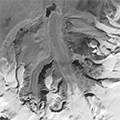
The dynamics of glaciers


 |
Scheme of ice flow from the accumulation to the ablation area
|
The dynamics of a glacier are basically governed by the following processes:
- accumulation of snow and ice in the upper glacier sections
- downward flow of this ice to the lower glacier parts,
- ablation of the ice, and
- runoff of the melted ice or atmospheric transport of evaporated ice/water.
Length and area changes of a glacier are determined by changes in one or several of these processes.
 |  |
ASTER satellite image of 29 May 2002 showing glaciers in the Himalayas
| |
Accumulation includes all processes that lead to a local increase of glacier mass. The accumulated snow is transformed to firn (i.e. old and compacted snow) and eventually into ice. Ablation includes all processes that lead to a local loss of glacier mass. As a glacier tends to balance its accumulation and ablation of mass under stable conditions, the ice mass flows slowly from the accumulation area towards the ablation area.
 |  | | |
Animation of two ASTER satellite images of the glacier in the ASTER image
|
Changes in length and area of a glacier can be due to alterations of accumulation and ablation. For example, if ablation increases (usually due to intensified ice melt from atmospheric warming) and accumulation remains stable, the ice flow decreases and the glacier length and area shrinks. On the other hand, if accumulation increases and ablation remains stable, the ice flow intensifies and the glacier grows in length and area. Runoff is the water that comes from melted ice and snow of a glacier, and runs down and away from the glacier. The result is a loss of glacier mass.
The ice flow in glaciers consists of two main components: ice deformation and glacier sliding. Both of these components add up to the total ice transport within a glacier.
 |  |
Close-up of animation
| |
In order to understand what ice deformation is, think of a pudding. Ice is a viscous medium, just like a pudding. If you slowly tilt the plate a pudding is sitting on, it will flow under gravity and ‘deform’ itself.
Glacier sliding is literally the ‘sliding’ of the glacier – the glacier slowly slides on its inclined bed of rock or debris. In most glaciers, the sliding component is more important than the internal deformation. Water beneath the glacier as well as the related water pressure decrease the friction of the glacier and increase the sliding factor. There are cases where an increase in water pressure can totally destabilise a glacier and lead to a so-called glacier surge.
Questions
Glaciers are very sensitive systems. A small change of even a single parameter can have a huge impact on the glacier itself. Describe what happens when:
- Accumulation is greater than ablation
- Ablation is greater than accumulation
- The mean air temperature increases
- The mean air temperature decreases
When answering these questions, consider the following processes: accumulation, ablation, flow, glacier shrinking and growing, and runoff.
Last update: 16 April 2013

 |  | 
Glacier ice flow

| | • | Introduction (http://www.esa.int/SPECIALS/Eduspace_Global_EN/SEMDPUZ14CH_0.html) |  | 
Background

| | • | Multitemporal image correlation (http://www.esa.int/SPECIALS/Eduspace_Global_EN/SEMWUUZ14CH_0.html) |  | 
Exercises

| | • | Worksheet introduction (http://www.esa.int/SPECIALS/Eduspace_Global_EN/SEM5WUZ14CH_0.html) |  | | • | Exercise 1: Correlation of repeated images (LEOWorks 3) (http://www.esa.int/SPECIALS/Eduspace_Global_EN/SEMRZUZ14CH_0.html) |  | 
Eduspace - Software

| | • | LEOWorks 3 (http://esamultimedia.esa.int/multimedia/LEOWorks3.exe) |  | 
Eduspace - Download

| | • | ASTER.zip (http://esamultimedia.esa.int/images/EduSpace/AST.zip) |  | | • | GoogleEarth file (http://esamultimedia.esa.int/multimedia/GoogleEarth_file eduspace_glacier.kmz) |  |

|

